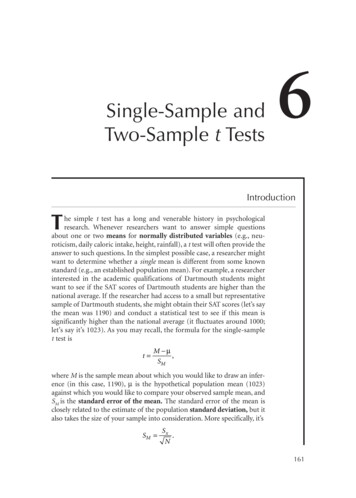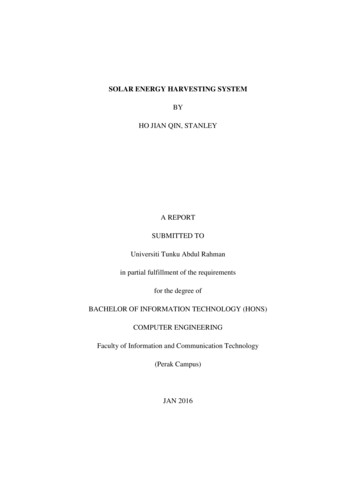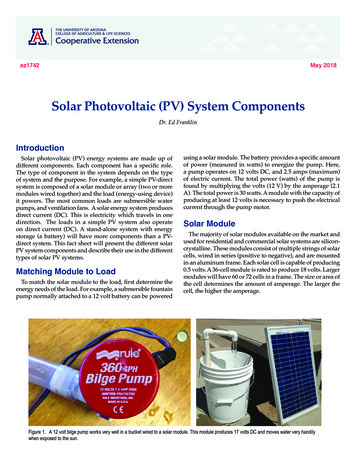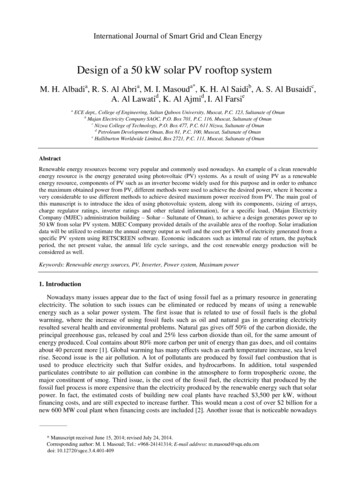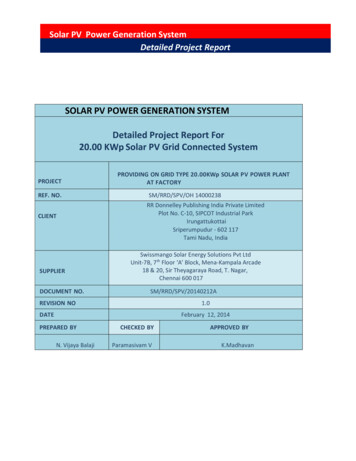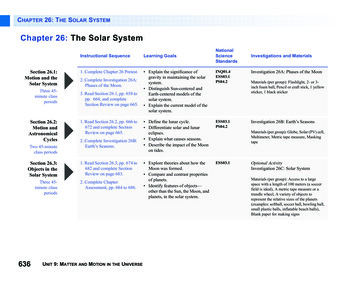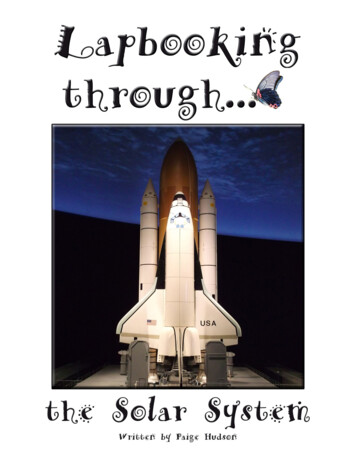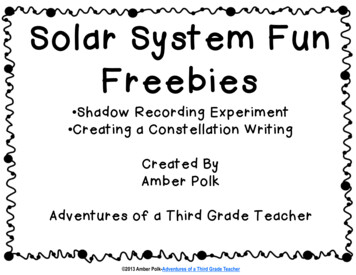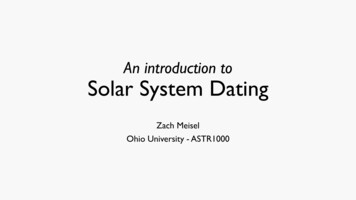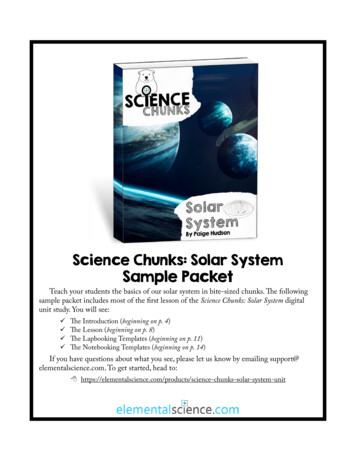
Transcription
Science Chunks: Solar SystemSample PacketTeach your students the basics of our solar system in bite-sized chunks. The followingsample packet includes most of the first lesson of the Science Chunks: Solar System digitalunit study. You will see:9999The Introduction (beginning on p. 4)The Lesson (beginning on p. 8)The Lapbooking Templates (beginning on p. 11)The Notebooking Templates (beginning on p. 14)If you have questions about what you see, please let us know by emailing support@elementalscience.com. To get started, head to: ks-solar-system-unit
5A Peek Inside a Science Chunks Unit1. Lesson Topic1Focus on one main idea throughout theweek. You will learn about these ideas byreading from visually appealing encyclopedias,recording what the students learned, and doingcoordinating hands-on science activities.22. Information Assignments3Find two reading options—one for youngerstudents, one for older students, plus optionallibrary books.3. Notebooking AssignmentsRecord what your students have learnedwith either a lapbook or a notebook. Thedirections for these options are included foryour convenience in this section along with thevocabulary the lesson will cover.44. Hands-on Science AssignmentsGet the directions for coordinating hands-onscience activities that relate to the week’s topic.55. Lesson To-Do ListsSee what is essential for you to do each weekand what is optional. You can check these offas you work through the lesson so that you willknow when you are ready to move on to thenext one.66. Lapbook TemplatesGet all the information you need to create alapbook on the subject.7. Notebook TemplatesHave all the sheets you need to create anotebook on the subject, including a glossaryfor the vocabulary terms.In the appendix you will find a blank activitysheet, a blank lab report sheet, and a reviewsheet (or quiz).7
THIS UNIT IS INTENDED FOR HOME USE ONLYThe images and all other content in this book are copyrighted materialowned by Elemental Science, Inc. Please do not reproduce this content one-mail lists or websites. If you have an eBook, you may print out as manycopies as you need for use WITHIN YOUR IMMEDIATE FAMILYONLY. Duplicating this book or printing the eBook so that the book canthen be reused or resold is a violation of copyright.Schools and co-ops: You MAY NOT DUPLICATE OR PRINT anyportion of this book for use in the classroom. Please contact us for licensingoptions at support@elementalscience.com.
Science Chunks - Solar System6Unit IntroductionScience Chunks - Solar System is a unique and versatile unit study that leads you through a surveyof the solar system. It is designed to be a gentle approach to homeschool science based on theUnit Study method suggested in Success in Science: A Manual for Excellence in Science Education byBradley and Paige Hudson. This study can be used as a stand-alone unit for elementary science.What Is Included in This UnitScience Chunks - Solar System includes the three keys to teaching science. With each lesson youwill be doing the following:9 Listening to (or reading) scientific information from visually appealing encyclopedias9 Dictating (or writing down) what the students have learned and seen using lapbooking ornotebooking9 Watching (and doing) hands-on science through a variety of science activitiesHere is how this works for a lesson.Section 1 - InformationThe elementary student is an empty bucket waiting to be filled with information, and scienceoriented books are a wonderful way to do that. These books can include age-appropriate children’sscience encyclopedias, living books for science, and/or children’s nonfiction science books.In this program, the reading assignments and additional books scheduled in the lesson fulfill thiscomponent. The reading assignments are broken for you into two levels: younger students (1st to3rd grade) and older students (4th to 6th grade).Our idea is that you will read these selections with your students, pausing to ask questions ordiscussing the information once you are done reading.Section 2 - NotebookingThe purpose of the notebooking component for elementary science education is to verify that thestudents have placed at least one piece of information into their knowledge bucket. You can usenotebooking sheets, lapbooks, and/or vocabulary words to fulfill this requirement.In this program, we have included two writing options, alapbook and a notebook, for you to use with your students.In the lapbook section, you will find all of the templates andpictures you will need to complete a lapbook on the solarsystem. In the notebook section, you will find all the pages youneed to create a simple notebook on the solar system, includingnotebooking sheets and a glossary.
Science Chunks - Solar SystemSection 3 - Hands-on ScienceScientific demonstrations and observations are meant to spark students’ enthusiasm for learningscience, to work on their observation skills, and to demonstration the principles of science for them.This component of elementary science education can contain scientific demonstrations, hands-onprojects, and/or nature studies.In this program, the coordinating activities at the end of each lesson fulfill this section ofelementary science instruction. If you would like to record what you have done, you can use one ofthe templates in the appendix pp. 79-80.What You Need in Addition to This GuideBooks ScheduledThe following books are what we used to plan the reading assignments for this unit:Younger Students - DK Children’s EncyclopediaOlder Students - Kingfisher Science EncyclopediaHowever, you could certainly use the encyclopedias you already have on hand or books from thelibrary. Simply look up the topic assigned for the day, read about it, and complete the section inyour lapbook.You will need also simple craft supplies and other science materials—see a complete list of essentialitems on p. 9.How This Unit WorksWe have included a to-do list with each lesson to give you an idea of what is essential and whatis optional. There are several ways you can schedule this unit. Here is a quick look at a few of theoptions.Possible Schedules for Your Week One Day – You can set aside about an hour to an hour and a half each week to complete allthe essential tasks in one day. Two Days – You can set aside about 30 to 40 minutes twice a week to complete all theessential tasks, plus a few more, in two days. On the first day, you can complete the readingassignments and either the lapbook or notebook assignments. On the second day, you cancomplete the coordinating activity and the vocabulary assignments as well as read any librarybooks. Three Days – You can set aside about 30 minutes three times a week to complete all theessential tasks, plus a few more, in three days. On the first day, you can complete the readingassignments and either the lapbook or notebook assignments. On the second day, you cancomplete the coordinating activity and write a lab report using one of the templates. On thethird day, you can do the vocabulary assignments as well as read any library books.7
Science Chunks - Solar System8 Four Days – You can set aside about 20 to 30 minutes four times a week to complete all theessential tasks, plus a few more, in four days. On the first day, you can complete the readingassignments and either the lapbook or notebook assignments. On the second day, you cancomplete the coordinating activity and write a lab report. On the third day, you can do thevocabulary assignments as well as read any library books. On the fourth day, you can do theoptional coordinating activity as well as read any library books.If you choose to complete one lesson per week, this unit will take you twelve weeks to complete.Final ThoughtsRead FurtherIf you would like to read more about philosophy behind the Science Chunks series, check outSuccess in Science: A Manual for Excellence in Science Education and the following articles from ourwebsite. The Three Keys to Teaching Science – This article shares the three keys to teaching science,including a free session that walks you through what each key can look like. https://elementalscience.com/blogs/news/3-keys The Basics of Notebooking – This article details the basic components of notebooking alongwith how a few suggestions on what notebooking can look like. tebooking Lapbooking versus Notebooking – This article takes a look at the differences betweenlapbooking and notebooking. -notebook Scientific Demonstrations versus Experiments – This article explains the difference betweenscientific demonstrations and experiments along with when and how to employ thesemethods. cientific-demonstrations-or-experimentsLast WordsAs the author and publisher of this curriculum, I encourage you to contact me with anyquestions or problems that you might have concerning Science Chunks - Solar System by emailing usat support@elementalscience.com. I, or a memeber of our team, will be more than happy to answerthem as soon as I am able. I hope that you will enjoy creating memories using Science Chunks Solar System! Paige Hudson
Science Chunks - Solar SystemMaterials ListLapbook MaterialsYou will need the following materials to complete the lapbook: 4 sheets of 8 ½” by 11” card stock OR 2 file folderColored pencils or crayonsMarkers for decorating the coverGlue stickScissorsStaplerNotebook MaterialsYou will need the following materials to assemble the notebook: Hole punch and 3 brad fasteners or string OR StaplesCoordinating Activity MaterialsYou will need the following materials to complete the essential coordinating activities: Lesson 1: Paper, string, and clothes hanger Lesson 2: Photo sensitive paper Lesson 3: Paint, picture of Mercury, and styrofoam ball or paper-mâché materials(balloon, newspaper, 1 cup of flour, ½ cup of water, and 2 tbsp of salt) Lesson 4: Paint, picture of Venus, and styrofoam ball or paper-mâché materials(balloon, newspaper, 1 cup of flour, ½ cup of water, and 2 tbsp of salt) Lesson 5: Eight sandwich-style cookies Lesson 6: Paint, picture of Mars, and styrofoam ball or paper-mâché materials (balloon,newspaper, 1 cup of flour, ½ cup of water, and 2 tbsp of salt) Lesson 7: Paint, picture of Jupiter, and styrofoam ball or paper-mâché materials(balloon, newspaper, 1 cup of flour, ½ cup of water, and 2 tbsp of salt) Lesson 8: Paint, picture of Saturn, and styrofoam ball or paper-mâché materials(balloon, newspaper, 1 cup of flour, ½ cup of water, and 2 tbsp of salt) Lesson 9: Paint, picture of Uranus, and styrofoam ball or paper-mâché materials(balloon, newspaper, 1 cup of flour, ½ cup of water, and 2 tbsp of salt) Lesson 10: Paint, picture of Neptune, and styrofoam ball or paper-mâché materials(balloon, newspaper, 1 cup of flour, ½ cup of water, and 2 tbsp of salt) Lesson 11: Paper and pencil or pen Lesson 12: Three feet of curling ribbon, a tennis ball, foil, and a straight pin9
Lessons
Science Chunks - Solar System11Lesson 1: Our Solar SystemInformationReading AssignmentsYounger Students – DK Children’s Encyclopedia p. 167 Milky Way, p. 233 Solar SystemOlder Students – Kingfisher Science Encyclopedia pp. 390-391 Galaxies, pp. 398-399 TheSolar System(Optional) Books from the LibraryThe Milky Way (Exploring Space) by Martha E. H. Rustad and Ilia I. RoussevThe Milky Way (Galaxy) by Gregory L. VogtThere’s No Place Like Space: All About Our Solar System (Cat in the Hat’s Learning Library) byTish Rabe and Aristides Ruiz13 Planets: The Latest View of the Solar System (National Geographic Kids) by David A. AguilarScholastic Reader Level 2: Solar System by Gregory VogtThe Planets in Our Solar System (Let’s-Read-and-Find. Science, Stage 2) by Franklyn M.Branley and Kevin O’MalleyNotebookingVocabularyGo over the following word with your students. Then, have them create a flashcard or copy thedefinition into the glossary. Solar system – A group of planets and other objects all in orbit around the Sun.(Flashcard p. 55 Glossary p. 77)Writing Instructions Lapbook – Have the students begin the Solar System lapbook by cutting out and coloringthe cover on p. 38. Then, have the students glue the sheet onto the front. Lapbook – Have the students cut out and color the “The Solar System” poem on p. 39. Oncefinished, have them glue the poem into the lapbook. Lapbook – Have the students cut out the template for the Solar System sheet on p. 39. Havethem color the pictures and label each of the planets in our solar system. (See the next page fora completed version.) Have the students also fill in “Milky Way” for the name of our galaxy.Then, glue the sheet into the lapbook. Notebook – Have the students dictate, copy, or write one to four sentences on the MilkyWay and our solar system on p. 63.Lesson Pages
Science Chunks - Solar System12Hands-on ScienceCoordinating Activity Solar System Mobile – Have the students make a hanger mobile of the solarsystem, using paper for your planets. Then, use string to attach the planets to aclothes hanger. You can use the planet templates in the appendix of this guideon pp. 81-82 for your project. (Optional) Milky Way Art – Have thestudents make their own Milky Waydrawing using a white pastel or crayonon black construction paper. Then, havethem use glue to trace the lines andsprinkle silver glitter over it.EssentialRead the appropriate reading assignment.Define solar system.Complete the lapbook or notebookassignments.Do the “Solar System Mobile” activity.OptionalGet one or more of the library books to read.Fill out a lab report sheet (p. 80) for one ofthe activities.Do the “Milky Way Art” activityLesson Pages
StudentLapbook Templates
Science Chucks - Solar System37Solar System LapbookYou will need four sheets of card stock or two file folders. If you are
Science Chunks Solar System 9 Materials List Lapbook Materials You will need the following materials to complete the lapbook: 4 sheets of 8 ½” by 11” card stock OR 2 file folder Colored pencils or crayons Markers for decorating the cover Glue stick Scissors Stapler Notebook Materials You will need the following materials to assemble the notebook: Hole punch and 3 brad fasteners or string .

